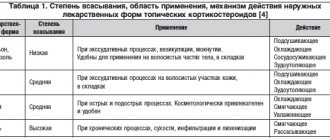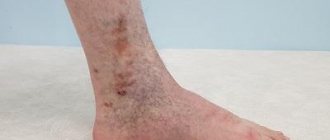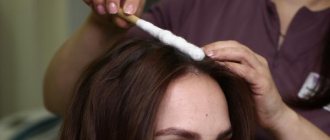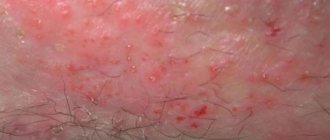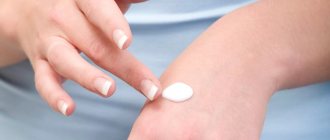Eczema is a non-infectious chronic skin disease that affects up to 10% of the world's population in one form or another. Women are more susceptible to pathology than men. Scientists have not established the exact reason for this statistics, but it is possible that the appearance of this disease is influenced by changes in hormonal levels after childbirth and frequent use of aggressive detergents in everyday life. Eczema is not contagious and only causes discomfort to the patient. There are several types of disease. All of them are characterized by severe itching, peeling and redness of the skin.
What is eczema
Eczema on the hands is an acute or chronic reaction of the body, which is accompanied by the appearance of a skin rash in the form of small blisters on various parts of the body. The rashes from the stage of redness and nodules turn into weeping erosions with the appearance of crusts. Throughout the course of the disease, the person experiences severe burning and itching. When scratching the rash, the risk of secondary purulent infection increases, which complicates the treatment process.
The disease is not contagious and is prone to frequent relapses. Occurs in 30-40% of patients who consult a dermatologist. Treatment of eczema is a rather lengthy process that requires an integrated approach. The choice of therapy depends on the cause, form and stage of the disease.
Self-medication, as well as uncontrolled use of any medications, will only worsen the course of the disease, leading to frequent exacerbations and complications.
Bibliography
- Current problems of dermatovenerology [Text]: materials of the conference. / State Educational Institution of Higher Professional Education SamSMU. - Samara: SamSMU, 2007. - 132 p.
- Baumann, L. Cosmetic dermatology: principles and practice [Text] = Cosmetic dermatology: principles and practice / L. Baumann; lane from English; edited by N. N. Potekaeva. - Moscow: Medpress-inform, 2012. - 688 p.: ill.
- Skin diseases [Text]: atlas / ed. N. V. Kungurova; Ministry of Health of the Russian Federation, Federal State Budgetary Institution Ural. Research Institute of Dermatovenereology and Immunopathology of the Ministry of Health of the Russian Federation. - Ekaterinburg: Publishing house "VIP-Ural", 2014. - 176 p.: ill.
- Macharadze, D. Sh. Atopic dermatitis in children [Text] / D. Sh. Macharadze. - Moscow: GEOTAR-Media, 2007. - 392 p.: ill. - (Current medical issues).
- Morgan, M. B. Atlas of deadly skin diseases [Text] = Deadly dermatologic diseases / M. B. Morgan, B. R. Smoller, S. K. Somach; lane from English; edited by A.V. Molochkova. - Moscow: GEOTAR-Media, 2010. - 304 p.: ill.
- White, G. Atlas of dermatology [Text] = Color atlas of dermatology / G. White; lane from English N. G. Kochergina; edited by O. L. Ivanova, N. G. Kochergina. - Moscow: GEOTARMEDIA, 2009. - 384 p.: ill.
- Dermatology [Text] = Dermatology. Vol. 1./ed. by Jean L. Bolonia; associate and artwork ed. JV Schaffer; section ed. JP Callen. — 2nd ed. - London: Mosby Elsevier, 2008. - ill.
- Fitzpatrick`s dermatology in general medicine [Text] = Fitzpatrick's dermatology in general medicine. Vol. 2. / ed.: K. Wolff. – 7th ed. – N.York [etc.]: McGraw-Hill Medical, 2008. – ill.
Reasons for development
The etiology of eczema has not been fully studied, but it is known that the cause of development is often heredity, the influence of endogenous and exogenous factors, as well as psychovegetative and immunological disorders. The following factors may be a trigger for the manifestation of symptoms:
- decreased immunity;
- allergic reaction;
- diseases of the endocrine system;
- stress, depression;
- diseases of the digestive system;
- exposure to high or low temperatures.
Under the influence of provoking factors, eczema often recurs, which leads to exacerbations and the appearance of new foci of rash.
Stages of eczema
The term “eczema” refers to the development of an acute allergic reaction to the skin. The disease has several stages and forms, which are important to recognize when making a diagnosis and selecting therapy. According to the nature of the course, eczema can be:
- Acute – symptoms develop rapidly. Small red blisters appear on the skin, inside the exudate. The skin becomes inflamed, swelling, itching, burning, and peeling appear. After the exudate dries, crusts form, followed by epithelization.
- Subacute - rashes appear as in the acute form with itching and inflammation, but without accumulation of exudate.
- Chronic – accompanied by a period of remission and exacerbation. In chronic eczema, new weeping foci of rashes are adjacent to dry crusts. There is much less exudate, but more dry crusts that itch and peel.
During the development of eczema, the disease goes through 4 stages of development:
- Erythematous - multiple red-pink spots appear on the skin.
- Papular - spots transform into nodules (papules), the skin swells.
- Vesicular - bubbles with exudate appear inside.
- Weeping - papules open, erosions (wounds) appear from which fluid is released.
- Peeling - erosions after the release of exudate become covered with a dry crust.
Several hours or days pass from the moment the rash appears until erosion becomes wet. When scratching the rash, the skin does not heal well, and there is a high risk of secondary infection.
Symptoms and forms
Clinical signs of eczema are quite pronounced. The disease can affect any part of the skin, but the rashes are most often localized on the body, head, arms or legs. Depending on the symptoms and classification of the disease, there are several types of eczema:
- True or idiopathic. There are symmetrical foci of inflammation on the skin, which turn into erosions, then dry crusts. The rash initially resembles bubbles when water boils. The rash most often affects exposed skin. When scratched and not properly treated, it is often complicated by a secondary purulent infection.
- Microbial. Develops as a result of traumatic injuries to the skin, against the background of fungal, viral or bacterial infections. Rashes develop around purulent wounds and contain infiltrate inside.
- Seborrheic. It affects the scalp, then moves to areas with the sebaceous glands. The skin becomes inflamed, swollen, and nodules, scales and crusts appear on it.
- Professional. Develops with constant contact with allergens: household chemicals, dust, cleaning products. A small rash can appear on any part of the body, but most often it is on the hands.
- Getting wet. Pink spots, swelling, and severe itching appear on the skin. Afterwards, exudate accumulates inside the papules, the rashes crack, wounds appear, which dry out, form a dry crust and peel off.
- Dyshidrotic. It affects the sweat glands, most often of the lower extremities. Accompanied by the appearance of serous blisters and seasonal exacerbation.
- Allergic. The development is caused by various allergens. In addition to the rash and weeping wounds, the patient is bothered by severe itching and burning.
The symptoms of eczema are quite similar to each other, so in order to determine the type, form and stage of the disease, you should consult a dermatologist and undergo a series of prescribed tests.
Causes and epidemiology
Eczema is a polyetiological disease. This term means a complex of factors that provoke the development of pathogenic processes. First of all, these include immune dysfunctions. The protective system perceives its own dermal cells as antigens and produces immunoglobulins for them. Due to this, localized skin manifestations in the form of areas of inflammation are formed.
Violation of intercellular immunity is confirmed during laboratory blood tests - an imbalance of glycoproteins will be detected, namely, IgG and IgE levels will exceed the norm, while IgM will manifest itself as a deficiency.
Neurohumoral-hormonal mechanisms have a similar effect. Scientists have noted a direct connection between the stage of eczema crisis and stressful situations. Local responses are also observed when the nerves of the peripheral system are damaged. An example of this is the post-traumatic group of diseases that develop around damaged areas of the skin.
Genetic predisposition represents the largest percentage of the likelihood of developing eczema. If one of your close relatives has a history of such a diagnosis, the chances of encountering the disease increase significantly.
Several years ago, scientists also proved the influence of dietary habits, namely trans fats, on this skin disease. According to studies, cases of diagnosing the disease in people who eat fast food are three times more common. In addition, any disturbances in the gastrointestinal tract can also provoke eczema.
The disease often occurs in patients with atopic diathesis; accordingly, the risk of developing the disease exists in people who consume allergenic foods. The incidence peaks in late life and is often characterized by seasonal outbreaks.
How to recognize eczema - diagnosis
You can recognize the symptoms of eczema by external signs, but to get a complete clinical picture, it is important to undergo a number of studies:
- general blood test, urine test;
- allergy tests;
- sowing tank
The results of the examination allow the dermatologist to identify the cause, make the correct diagnosis, and prescribe the necessary treatment. If there is a suspicion that eczema has developed against the background of chronic diseases, the doctor will prescribe additional tests and consultation with other specialized specialists (therapist, endocrinologist, gastroenterologist, psychotherapist, etc.).
Treatment of eczematous dermatitis
Before starting treatment for eczematous (allergic contact) dermatitis, you need to undergo an examination to establish an accurate diagnosis, because eczematous dermatitis has similar symptoms to eczema, atopic dermatitis and other skin pathologies.
For diagnosis use:
- Scraping of detachable skin flakes - for microscopic examination and exclusion of fungal infection.
- In rare cases, a histological examination may be performed to determine the type of dermatitis and exclude other skin diseases.
- General analysis of urine and blood - to identify concomitant diseases; for the same purpose, consultations with specialized specialists (ENT, gastroenterologist) are indicated.
- Analysis to identify the source of the allergy.
Having received the results of tests and studies, the doctor will make the correct diagnosis and prescribe a treatment regimen, taking into account the characteristics of the body.
Treatment of eczematous dermatitis involves an integrated approach:
- Exclusion and removal of allergens from the body;
- Identification and treatment of diseases that can trigger the development of dermatitis or an allergic reaction;
- Antihistamines and anti-inflammatory drugs are prescribed to eliminate symptoms, relieve swelling and itching, drugs for local treatment, a daily routine with a full 8 hours of sleep is indicated.
Self-medication or ignoring the disease is unacceptable; the disease can cause complications and occupy a large area of the skin. If you follow your doctor's recommendations and choose the right treatment, Eczematous (allergic contact) dermatitis goes away in a short time, without serious consequences for health.
Eczema Treatment Methods
Treatment of eczema should begin with eliminating the factors that provoke its development: neuropsychiatric disorders, allergens, drugs, household chemicals. At the same time, the doctor selects a treatment regimen that will include systemic and local therapy.
Systemic therapy includes taking medications aimed at relieving the symptoms of the disease and reducing the risk of exacerbation. The doctor prescribes a number of medications, most often these are:
- antihistamines;
- sedatives;
- vitamin therapy;
- glucocorticosteroids orally and place.
The dose, duration of use and trade name of drugs for the treatment of eczema are determined by a dermatologist individually for each patient. In case of a chronic course of the disease, frequent exacerbations, the doctor may prescribe a plasmapheresis procedure or other methods of extracorporeal hemocorrection.
Outside of exacerbation of eczema, good results can be obtained from physiotherapy:
- ozone therapy;
- magnetic therapy;
- laser treatment;
- cryotherapy;
- therapeutic mud and baths.
Physiotherapeutic treatment and its duration are selected by a physiotherapist on the recommendation of a dermatologist.
Treatment of eczema is impossible without following a diet. The patient should exclude spicy and fatty foods, alcohol, fried and smoked foods, and sweets from the diet. It is recommended to eat light, fortified and healthy foods that will not cause allergies. During the treatment period, it is important to give up alcohol and smoking. The doctor will give each patient recommendations on nutrition and lifestyle.
Why does coin-shaped eczema occur?
Doctors cannot yet clearly name the cause of coin-shaped eczema. What is known for sure is that the disease always has an infectious component. At the same time, such eczema is considered polyetiological, i.e. it can be caused by many different reasons. But regardless of this, infection always plays a major role in the development of dermatitis, which suppresses the immune system.
According to modern dermatologists, coin-shaped eczema is caused by a violation of the immune system: cellular (it is provided by leukocytes) and humoral (antibodies are the defenders - special proteins produced by cells). This is due to the fact that the body has a focus of chronic infection (otitis, tonsillitis, rhinitis), to which excessive sensitization occurs - increased sensitivity to the influence of irritants, causing allergies.
The risk of encountering coin-shaped eczema increases:
- in case of malfunction of the nervous system;
- changes in hormonal levels;
- excessive sweating;
- diabetes mellitus;
- frequent stressful situations;
- metabolic disorders;
- poor nutrition;
- chronic diseases of the ENT organs;
- oral infections.
To the list of factors, you can add medications that, against the background of a hereditary predisposition to dermatitis, reduce immunity and can cause coin-shaped eczema. Heredity is no less important in the development of the disease. If one of the parents has such a diagnosis, then the probability of its occurrence in the child is 40%, if both - then 60%.
Disease prevention
Prevention of eczema consists of following a hypoallergenic diet. It is important to abandon all factors that can provoke exacerbations. Pay attention to personal hygiene and do not use cosmetics containing chemicals or synthetic substances. Eliminate any stressful situations and lead a healthy lifestyle.
Eczema is a chronic disease that causes not only physical but also psychological discomfort and worsens a person’s quality of life. Early diagnosis, proper treatment and compliance with medical recommendations will help keep the disease under control, reduce the frequency of exacerbations, and minimize complications.
